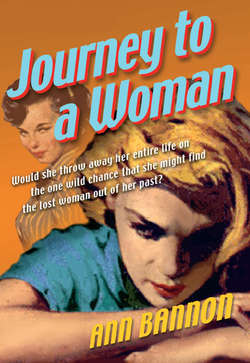Читать книгу Journey To A Woman - Ann Bannon - Страница 5
II. Personality Portraits
ОглавлениеNot everybody likes to travel, but almost everybody loves a journey of self-discovery, especially if it leads to the uplands of love. This book is an odyssey from sorrow to sunshine; from the drama and heartache of breakup to the astonishment of passion. If the preceding book, Women in the Shadows, was a story of breaking away from smothering relationships and claiming the right to define yourself (even if you got it wrong, be it said!), Journey to a Woman is more about achieving youthful maturity, coming to terms with who you really are. It’s about what happens to three strong, beautiful women when one of them—Beth—rediscovers her passion for another—Laura—only to fall headlong into the arms of the third—Beebo Brinker herself.
When I first started writing these books, I was a woman in love—not just with a few individuals, but with a whole community, the entire world full of wonderful women and endearing gay men. I idealized them all. I was in love with being in love with them. They could do no wrong in my eyes. But time went by. I listened, I watched and learned. I was also doing my own growing up and having to accept, book by book, that people aren’t perfect—fascinating and lovable but not flawless. I had to include myself in that “not-flawless” category, too.
People have asked if I am the Beth in these stories. I am reminded of the response Gustave Flaubert gave when he was asked the identity of Madame Bovary. “Madame Bovary,” he replied calmly, “is me. Madame Bovary, c’est moi.” The French have been scratching their heads and repeating the phrase ever since. But Flaubert had hit on something. For any writer, all of our various characters are “us” when we create them. I have always responded that Beth was based, physically and socially at least, on a former sorority roommate who inspired lust in many hearts, more than one of them womanly. That said, however, perhaps it is fair to allow that there is a lot of me in Beth, and a lot of her problems are the ones I was wrestling with in my twenties, especially the awkward relationships, skewed by chaotic, unsorted emotions. Beth was a woman who needed women, heart and soul, and didn’t know how to give herself permission to reach out to them. We differed most in two ways: she spoke out to her husband about her fears and misgivings while I swallowed mine. And she was dubious about her feelings for her children while I was passionately attached to mine.
So Beth was vulnerable when the lovely but dangerous and fatally wounded Vega crossed her path. We have all had the experience she had: a first breathtaking glimpse of a bewitchingly beautiful human being, and perhaps even the pleasant shock of seeing a responsive spark in that person’s eyes. But after you bring them home you find something scary under the irreproachable veneer. They are hurt and want to hurt someone back; they need you to fix them, while you need them for love. They don’t have it to give, and you can’t supply the fix. It’s a match made in purgatory. What to do? This is where you learn fast how rocky saying goodbye can be.
There was a woman living near me in Southern California who served as the original of Vega Purvis. She was handsome, sleek and chic, witty, and, in Edward Arlington Robinson’s apposite phrase, “imperially slim.” She could be endearingly funny about her physical ills, in a way that made you want to cuddle and comfort her. It was Vega herself who described her abdominal scars as resembling a ball of yarn tangled up by a kitten. But she carried a freight load of psychological damage everywhere with her, and it gave her a mercurial temperament. I could never wait to spend time with her, and never wait to get away home.
My fictional Vega was also a woman whose prejudices reflected almost perfectly those of her homophobic family, and yet who broke out of that box from time to time. Her forays were thrilling, risky, and ultimately disastrous, as Beth discovered. But they do bespeak the strength of that drive to find and possess and yes, love, one of your own. And always, in that era and even now, there were perplexed and resistant men hovering in the background—impatient husbands or brothers or uncles, wondering why their influence doesn’t sweep away such treacherous notions from their women’s heads.
Some women take refuge behind a man, as Laura did, and some men behind a woman, as did Jack Mann in this tale. Laura never gave up her delight in women, and they remained the romantic joy of her life. But she wanted children and so did her supportive and affectionate best gay friend, Jack. They made common cause to provide a home for their child and a facade of respectability each for the other, a sort of honorable camouflage to shield them from the ostracism of their social circle.
Knowing none of this, and running almost as much from Vega as Charlie, Beth arrives in New York obsessed with tracking Laura to earth and virtually devouring her with the resurgent sexual excitement she thought she had forever abandoned with her marriage. And when, in her search, she runs into the provocative and manipulative writer, Nina Spicer, who leads her to Beebo Brinker, the stage is set for a fiery intersection of different personalities, conflicts, and clashing needs. And ultimately, of course, for resolution in love. (These were the pulps, after all!)
